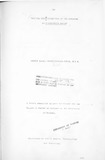| dc.description.abstract | Although the modes oj! transmission of Cysticercus bovis to cattle and Taenia saginata to man have been known for a number of years, bovine cysticercosis and human taeniasis still exist as a world-wide problem.
The magnitude of the economical and nutritional losses caused by bovine cysticercosis is unknown but can be estimated to be considerable, especially in highly endemic areas.
Many factors may account for the lack of effective control measures, one of them being the lack of a reliable antemortem diagnostic procedure in cattle.
Several attempts have been made to establish a specific and sensitive immunodiagnostic procedure which will serve as an adjunct to the present meat inspection procedures. Several achievements have been recorded in this regard, despite the disappointments encountered.
Work described in this thesis attempts to define the antigens of C. bovis and T. saginata and their relationship
to some common parasites. Some of the antigens were shown to possess a high degree of specificity which is deemed necessary for immunodiagnostic procedures.
This work can be divided into four parts. The first part describes the immunological characterization of the antigens of C. bovis and T. saginata. The antigens were
compared by the double immunodiffusion method in gel
using specific antisera produced :in goats, rabbits and calves. Three antigenic components were found to be common to C. bovis and T. saginata but only one of these was unique to these parasites. The other two components showed cross reactivity with other parasitos. As the unique antigon was dotoctod at the end of this study, time did not allow further work on this promising finding.
The antigens of C. bovis origin were further examined by crossed immunoelectrophoresis. A reference pattern was established using pooled rabbit anti-C. bovis serum and a homogenate of "Inner menbrane-scolex" of C. bovis (bladder worm from which the fluid had been removed) as the reference antigen. The precipitin lines were arbitrarily numbered starting with the most anodic component. Fifteen antigen- antibody precipitating systems were defined by this method.
Antigen preparations derived from C. bovis and C.tenuicollis were also examined for the presence of host components, since it has been established that many cystic stages of parasites contain such components which may be responsible for non-specific reactions in several serodiag- nostic tests for parasitic infections. The major contaminating
host components in C. bovis and C. tenuicollis were shown to be IgG and albumin. All the antisera prepared against C. bovis and C. tenuicollis antigens were, therefore, absorbed with insoluble whole serum immunoadsorbents to remove reactivity with host components. Since other workers have described the presence of blood group antigens, such as P1-active substances and ABO(H)-like substances, it was
considered necessary to absorb the antisera with red cells of appropriate groups also.
In Iho second part of this study, tho cross-roactionu between C. bovis, T. gaginata and more than 16 other parasites
were examined by immunodiffusion in agar gel. A wide range of cross-reactivity was found, but somo antigens of
C. bovis gave cross-reactions with only a few parasites, notably C. . cellulosae, C_. tenuicollis and T. hydatigena, using antisera to C. bovis and T. saginata. Similar reactions were observed when goat anti-C. tenuicollis serum was used.
The precipitin line which was common to C. bovis, T. saginata, T. hydatigena, C. tenuicollis and C. cellulosae was cut out • of agar gel, sonicated and inoculated into a goat to make a specific antiserum to this antigen which showed a limited cross-reactivity. Using the crossed immunoelectrophoresis reference pattern established for C. bovis antigens and the specific antiserum in the intermediate gel, the crossreacting
antigen was shown to be identical with Antigen ±1 of the reference system.
The third part of this work involved the isolation and characterisation of Antigen 11. The antigen was eluted from an affinity column prepared by coupling the IgG fraction
from the Antigen 11-specific antiserum. Antigen 3A was further characterised by isoelectric focusing and polyacrylamide gel electrophoresis into which sodium dodecyl sulphate was incorporated (SDS-PAGE) . Antigen 11. was found to have a molecular weight between 63,000 and 78,000 daltons by SDS-PAGE analysis and was isoelectric at pH 4.47 to 5.50.
This antigen was used in the last part of this work.
In the fourth and last part of the study, an attempt was made to determine whether Antigen 11could be of serodiagnostic value. Serum samples from known experimentally
infected and non-infected cattle were tested for the presence of antibodies to Antigen JJ. using the solid-phase radioimmunoassay. High levels of IgG and comparatively low levels of IgM antibodies were detected. The IgG antibody
levels were detected 5 weeks post infection and they reached the peak at week 24. Thereafter, the antibody levels showed a gradual fall up to week 64 post infection when the last sample was tested. There was a clear-cut antibody level difference between the known infected and non-infected animals from non endemic areas, which shows that Antigen 11could be of diagnostic value. The ability of Antigen _11 to detect naturally infected animals has not yet been investigated
and more work is needed to define its reactions with sera from animnls infected with other parasites.
The possible use of Anti gen JJ. of C. bovis which shows a narrow range of cross-reactivity may reduce substantially
the occurrence of non-specific reactions in serodiagnostic tests. However, further studies are required on the other 14 antigens, especially the one which appears to be unique to C. bovis and T. saginata | |

